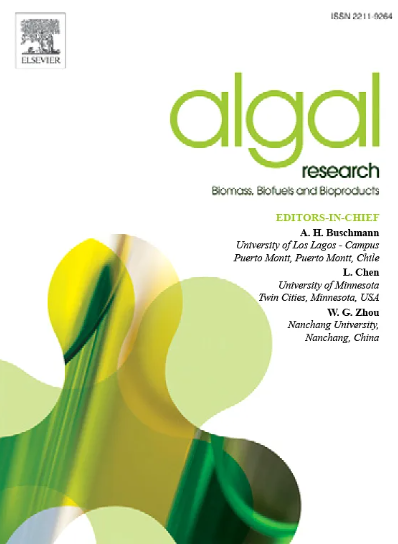Growth characteristics and nutritional quality of two typical microalgae: Interactive effects of temperature, light, and nitrate
IF 4.6
2区 生物学
Q1 BIOTECHNOLOGY & APPLIED MICROBIOLOGY
Algal Research-Biomass Biofuels and Bioproducts
Pub Date : 2025-03-18
DOI:10.1016/j.algal.2025.104004
引用次数: 0
Abstract
In the context of increasing demand for food products, microalgae garnered considerable interest due to their essential roles in supporting aquatic food webs and serving as bait in aquaculture. In this regard, it is crucial to clarify their optimal culturing conditions, including both single-factor and multiple-factor combinations. In this study, Thalassiosira weissflogii and Pyramimonas sp. were cultivated under five levels of temperature, light intensity, and nitrate to determine their optimum growth conditions. A full factorial experiment was then conducted, employing two levels for each factor (10 and 25 °C for temperature; 50 and 150 μmol photons m−2 s−1 for light intensity; 2 and 100 μmol L−1 for nitrate concentration) to investigate the growth, photosynthesis, and amino acid and fatty acid compositions of the two species. T. weissflogii exhibited an optimal growth temperature 4 °C higher than that of Pyramimonas sp., while the latter performed better at low temperatures. The full factorial experiment revealed that temperature was the most significant factor influencing the growth of two species. The fatty acid composition of T. weissflogii was primarily affected by temperature changes, with an average 4 % higher percentage of polyunsaturated fatty acids observed at high temperature. Nitrate concentration emerged as the key factor influencing photosynthetic rates, as well as soluble protein and carbohydrate contents, while it was the only factor affecting amino acid profiles. Generally, nitrate limitation resulted in lower photosynthetic rates, higher soluble carbonate contents, while soluble protein content and amino acid composition varied depending on the species and culturing conditions. These findings provide valuable information and reference points for enhancing biomass accumulation and the production of active substances in microalgae cultivation.
求助全文
约1分钟内获得全文
求助全文
来源期刊

Algal Research-Biomass Biofuels and Bioproducts
BIOTECHNOLOGY & APPLIED MICROBIOLOGY-
CiteScore
9.40
自引率
7.80%
发文量
332
期刊介绍:
Algal Research is an international phycology journal covering all areas of emerging technologies in algae biology, biomass production, cultivation, harvesting, extraction, bioproducts, biorefinery, engineering, and econometrics. Algae is defined to include cyanobacteria, microalgae, and protists and symbionts of interest in biotechnology. The journal publishes original research and reviews for the following scope: algal biology, including but not exclusive to: phylogeny, biodiversity, molecular traits, metabolic regulation, and genetic engineering, algal cultivation, e.g. phototrophic systems, heterotrophic systems, and mixotrophic systems, algal harvesting and extraction systems, biotechnology to convert algal biomass and components into biofuels and bioproducts, e.g., nutraceuticals, pharmaceuticals, animal feed, plastics, etc. algal products and their economic assessment
 求助内容:
求助内容: 应助结果提醒方式:
应助结果提醒方式:


